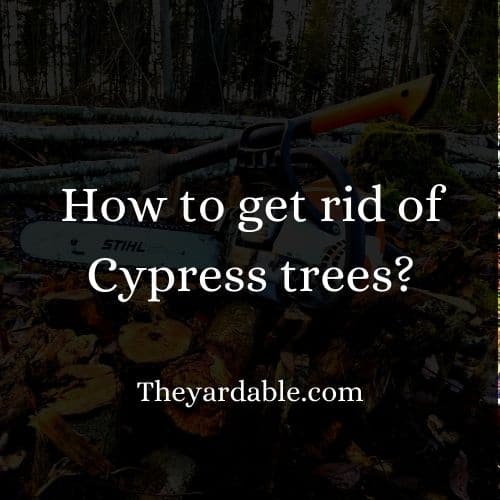
Cypress or Cupressaceae trees are native species in North American, known for their fast growth and resilient nature. Because of their short needles and feathery appearance, Cypress is a great choice for landscaping. It can withstand pretty harsh conditions once they reach maturity.
Let’s take a look at some of the ways to remove your cypresses as well as kill their root system.
How to kill Cypress trees?
When it comes to killing Cypress or Cupressaceae trees, you can choose from a variety of options. Each of them has its pros and cons both in terms of cost and efficiency. Let’s take a look at some of these methods.
- Foliar Spray: This method is most suitable for trees that are under 15 feet (5 meters) tall. Simply spray the foliage with a selective weed killer. Make sure there is no wind that day as the herbicide can be carried far away.
- Cutting the tree down and treating the stump with Herbicides: This tree killing method is one of the oldest and most used one. Once you cut the tree down, there is a chance it might sprout back. Treating it with herbicides will prevent the tree’s further growth.
- Gridling or ring barking: You simply have to remove a strip of bark throughout the circumference of the tree and treat it with an herbicide. Make sure the strip of bark is at least 4-6 inches wide. This will stop any nutrients from travelling across the tree.
- Basal Bark treatment: Spray the bottom 20 inches of the tree with a chemical like Garlon XRT or Triclopyr. The chemical will absorb within the bark and effectively kill the tree.
- Injecting the tree with killing chemicals: You will need to drill 2 inches (4 cm) deep holes along the circumference of the tree at a downward angle. After drilling the holes, simply spray or squeeze in herbicides into the holes.
- Cut surface treatment: Make the cuts every 2-3 inches of the circumference. The cuts have to be deep enough to expose the inner white surface. Then spray the cuts with a chemical like Tordon or Roundup.
It should be noted that even though any of the above methods can be used to kill a Cupressaceae tree even while standing, it will still have to be taken down and dealt with later on.
The best way to kill a small Cypress tree
Some methods are preferable for killing small Cupressaceae trees as they are more efficient and cost-effective. Besides removing the tree right away, the Foliar Spray method would be most suitable here.
- Make sure there is no wind during this as the herbicide can get carried away.
- Use an effective herbicide like Roundup or Ohto. (can be sound on my recommended procucts page here)
- Spray the foliage of the Cypress with the herbicide.
The herbicide will be absorbed by the leaves and transported to the roots, effectively killing the tree over time. In most cases, depending on the size of the tree, this method requires multiple treatments.
The most effective season to use this method is summer and spring as the foliage cover is high.
The best way to kill a big Cypress tree
A mature Cupressaceae can grow up to be around 80 feet tall, therefore you will have to look for a killing method that is both fast and easy.
Ringbarking would be the easiest and the most efficient method for killing a large Cypress or Cupressaceae as it will stop the nutrient flow from the roots to the stems and leaves, killing the tree over time.
- You will need to either get a hatchet, hammer and chisel or chainsaw for this method.
- Simply remove a ring of bark around the entire tree, about 4-8 inches wide.
- For extra measure, spray some herbicide on the exposed area.
You can use this method without using an herbicide but there is a chance that the tree survives the ringbarking process.
This method is also preferred if you want to use the Cypress as firewood because after ringbarking the tree will slowly start to lose moisture while still standing. Low moisture content is essential to use a tree as firewood, and seasoning before cutting a tree down helps to save room and time.
Killing a small Cypress compared to a big Cypress – What are the differences?
Some methods of killing trees might just not work with larger trees. One such example is the foliar spray. This method works best when the distance from the foliage to the roots is less. This makes transporting the herbicides and chemicals to the roots faster and easier.
The other major difference is the time taken no matter which method you use. If you use ringbarking for both sizes, the smaller Cupressaceae will die much faster. With the bigger tree, you will have to be more patient.
One unique thing about the Cupressaceae is that they tend to develop ‘knees’ when they mature. These are protruding roots that can grow up to about 6 feet in height. When removing the Cupressaceae, cutting down these extra parts can be quite tedious.
Can you kill a Cypress without cutting it down?
Cypress or Cupressaceae can be killed without cutting them down. The preferred methods for doing so would be ringbarking, basal bark treatment, or cut surface treatment. These methods are not only effective but cheap at the same time.
You have to consider the fact that once the tree is dead, it will start decomposing over time and it can fall on nearby property.
Hire a professional tree removal service
Hiring a professional for removing a Cupressaceae tree has its own benefits. You won’t have to worry about the cutting and transporting procedure once the tree is dead. A professional can also take care of the ‘knees’ which Cupressaceae tend to develop. These issues might not be as big if the tree is small but for large Cypresses, it can be quite tricky.
On top of this, the cost factor also plays an important role. Figuring out all of these separate logistical details can turn out to be quite costly.
Take a look at my tree removal cost article here.
Things to consider while removing a tree on your own
If you are not experienced with killing or removing trees, there are some unexpected challenges that can come your way. Large Cupressaceae trees will start decomposing once they have been killed, which increases their chance of falling down. This can be a hazard if the tree is located near your house or near power lines.
One more thing to keep in mind here is the ‘knees’ which I previously mentioned. These parts of the tree can be quite a nuisance, they protrude out of the surface and can’t simply be cut down. You have to kill the entire root system to effectively get rid of the tree.
The root system will be killed by treating the tree with herbicide in the removal process.
Frequently Asked Questions
Can you kill a Cypress tree with vinegar?
Although Vinegar is harmful to most plants and trees and it can effectively kill grass, it won’t be as effective in killing an already established Cupressaceae. Undiluted white vinegar with salt can be used to prevent shoot and stump growth. The use of a chemical herbicide is more efficient.
Can you kill a Cypress tree with diesel?
Yes! Diesel can be used to stop any tree from growing, including cypress. Diesel can even kill trees if it is poured directly into drilled holes, on the stump, or on the roots. Diesel will also contaminate the nearby soil by killing other plants as well.
Can you kill a Cypress tree by directly attacking its ‘knees’?
The ‘knees’ are protruding root systems of the tree, so if you use removing methods listed in this article, herbicides used to treat the tree would directly travel within the root system and effectively kill the tree.
Conclusion
There are a number of ways of killing Cypress or Cupressaceae trees, the easiest method for small trees is considered to be foliar spray while for bigger trees you should stick to girdling and treating the area with herbicide.
Recommended reading:

Hi!
I am the guy behind Theyardable.com. I grew up on a homestead and I am here to share the knowledge I have and things I learn while living in the countryside.
